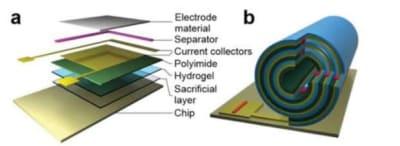Not so many years ago, computers were so big they took up entire rooms, but today some processing units are as small as a few specks of dust, and even so, shrinking computer batteries to fit that size is proving more difficult.
With little storage space, even the smallest computers must rely on ultrasonic cells or photovoltaics to continually fill small batteries with energy from vibrations or sunlight, and this has its downsides because the computer will not work without a stable power source or in dark places such as The human body, so some scientists in Europe are developing an alternative structure that is a very small battery that relies on folding very thin layers like origami, according to the "Science Alert" website.
Researchers in Britain have developed a battery that is the smallest ever, so far they have developed a prototype, but the preliminary results are encouraging, and they published the results of their research on this battery and wrote in it: « There is an urgent need to develop high-performance batteries for the millimeter and sub-millimeter system because these energy storage systems will facilitate the development of truly autonomous microsystems.”
The inventors of the new micro-battery developed it using a theory based on squeezing a solid electrolyte between two tiny, thin-film coated electrodes, one positive and one negative.
In a cubic millimeter scale, it is very difficult to roll thin and brittle materials into this kind of shape by external pressure, but fortunately there is another way to make the material fold on its own, It is called "Little Origami".
The new technique kind of works like a rolling window curtain, and the researchers were able to achieve this motion by pinning one side of the thin material to create a curtain window strip at its core. In the end, the team was able to assemble a prototype of the tiny battery in an area of just 0.04 square millimeters. This provides eight times more capacity than a flat battery of similar size can achieve.

Not so many years ago, computers were so big they took up entire rooms, but today some processing units are as small as a few specks of dust, and even so, shrinking computer batteries to fit that size is proving more difficult.
With little storage space, even the smallest computers must rely on ultrasonic cells or photovoltaics to continually fill small batteries with energy from vibrations or sunlight, and this has its downsides because the computer will not work without a stable power source or in dark places such as The human body, so some scientists in Europe are developing an alternative structure that is a very small battery that relies on folding very thin layers like origami, according to the "Science Alert" website.